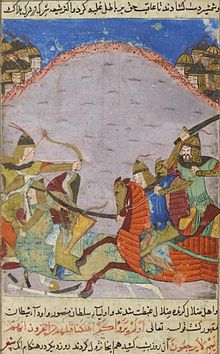| Battle of Bolnisi | |||||||
|---|---|---|---|---|---|---|---|
| Part of Jalal al-Din's invasions of Georgia | |||||||
 The Georgians (left) against the Khwarezmians (right) in the battle of Bolnisi in 1227. From the Tarikh-i Jahangushay manuscript created in Shiraz, Iran, in 1438. | |||||||
| |||||||
| Belligerents | |||||||
| Khwarazmian Empire |
| ||||||
| Commanders and leaders | |||||||
| Jalal al-Din Mangburni | Avag Zakarian | ||||||
| Strength | |||||||
| Unknown | Unknown | ||||||
| Battles involving Jalal ad-Din | |
|---|---|
The Battle of Bolnisi (Georgian: ბოლნისის ბრძოლა) was fought in 1228 AD near Bolnisi, then part of the Kingdom of Georgia. The invading Khwarazmid Empire was led by Jalal ad-Din Mingburnu, its last Sultan, who was driven from his realm by the Mongol Empire and was trying to recapture lost territories.
Background
Jalal ad-Din's first encounter with the Kingdom of Georgia occurred in 1225, when his army inflicted a crushing defeat on the Georgians at Garni, bringing about the end of Georgia's medieval heyday. Next year, Jalal ad-Din marched on to Tbilisi, forcing Queen Rusudan of Georgia and her court into flight. The Georgian forces, left in defense of the capital, put up a fierce resistance, but Jalal's forces eventually broke into the city with the assistance of local Muslims on 9 March 1226. The victorious Khwarazmian soldiers sacked Tbilisi and massacred its Christian population.
When Jalal failed to capture Ahlat, the Georgians briefly recaptured Tbilisi, but on Jalal's return in 1227, the small garrison chose to put the city to the torch themselves. Although the queen Rusudan remained in Kutaisi.
Battle
Avag did not give up and assembled an army composed of Georgians, Kipchaks, Alans and Vainakhs. In 1228 he attacked the Khwarazmians at Bolnisi where Jalal ad-Din's forces were waiting. Jalal ad-Din's army included Kipchak banners, consisting of 20,000 men in the Georgian ranks and appealed to them, 'lending a certain Qoshqar to them with a loaf of bread and salt to remind them of their 'former obligations' to his house. The Kipchaks withdrew support from the Georgians. The battle ended with a Khwarezmid victory and is marked as a disastrous event in Georgian history due to betrayal.
References
- Machitadze, Archpriest Zakaria (2006), "The Hundred Thousands Martyrs of Tbilisi (†1227)", in The Lives of the Georgian Saints Archived 2008-06-14 at the Wayback Machine. pravoslavie.ru. Retrieved on 2011-11-13.
- ^ Baumer 2023, p. 35.
- ^ Rayfield, Donald (2012). Edge of Empires: A History of Georgia. London: Reaktion Books. p. 124. ISBN 978-1780230306.
- Anatoly M. Khazanov, Andre Wink (2001). Nomads in the Sedentary World (Curzon in Association With Iias). Routledge. p. 51. ISBN 9780700713691.
Sources
- Guchava V., Georgian Soviet Encyclopedia, II, p. 452–453, Tbilisi, 1977
- Baumer, Christoph (2023). History of the Caucasus. Bloomsbury Publishing. ISBN 9780755636303.